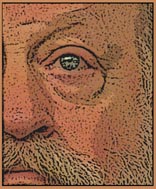
 |
Philly-Bob’s Visual Art 2013One man's art, using digital manipulation of images from the Public Domain to make creative remixes. In some circles, this is called Post-Post-Modernism, or "po-po-mo." |
Artist's Statement
Although I have been interested in art and graphic design all my life, I only began working seriously after my retirement in 2011. These images -- digital manipulations of images from the Public Domain -- are highly personal works of art. I am currently working in a graphic style influenced by the grainy biological "light shows" I saw when I was in a near-hallucinatory state from the anesthesia after open-heart surgery. The subject matter is also influenced by what I see when I dream -- the surreal, the ordinary, the puzzling, the unsettling.
I try to keep up on the latest additions to the Public Domain (PD), a daunting task. For a year I followed the U.S.-based Internet Archive which has over 5 million PD files and adds a new one every minute. Lately, I have been looking at Gallica, the PD site of France. It's all like drinking from a firehose, a post-retirement desk job. Because of the world's crazy copyright laws, much PD material is monochromatic, between 50 and 100 years old. This gives my work an antique look.
For more on PD issues, see this Wikipedia article, this group, this manifesto, and this online magazine. Here are some other, international sources, and here is a recent article about PD issues. The Open Knowledge Foundation is working on a Public Domain Calculator to make it easier to figure public domain issues.
For maximum effect with my images, click on the image until it is full-size, which may be larger than your computer screen.
Romanian Glass Negative Collection
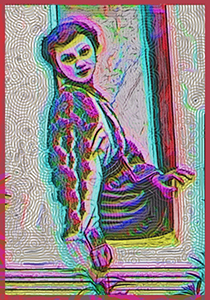
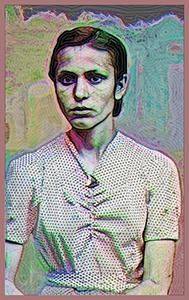
Over at Flickr's Commons, there's a new library collection: the Costica Acsinte collection, a library of some 5000 glass negatives and paper prints from Romanian photographer of that name, who lived from 1897 to 1984. On the left is my version of one of the collection's most popular photographs, a 1939 picture of a young girl in traditional costume posing in a window (Link1). On the right is my version of an undated photograph (Link2) named (presumably after the subject) Fata, although to tell you the truth, this is what I imagine the philosophical principle Fate ("the things that will happen to a person") would look like -- lean, serious, with a compelling gaze that burns right through you.
...
Happy New Year, Y'all!
Sources:
Link1: www.flickr.com/photos/costicaacsinte/11210582273/
Link2: www.flickr.com/photos/costicaacsinte/11654700095/
Tuesday, December 31, 2013
Alfred Hottes II: Post-retirement Drawings
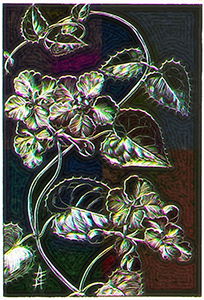
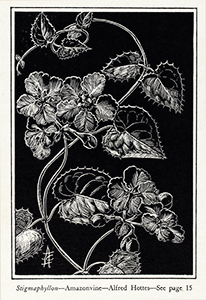
After a career teaching Horticulture at Ohio State, Alfred C. Hottes moved to California and for the last few years of his life -- he would die in 1955 -- he graced the covers of California Garden with his delicate and loving plant drawings. These are detailed, but not technical -- just joyful celebrating the accidental grace of botanical form. I believe he also switched from pen-and-ink to scratchboard. Here are two versions of his 1951 cover drawing (Link1) of the sinuous Amazonvine ("a slender, twining climber"). To the left is my recolored version, to the right is Hottes' original... Hottes' development intrigues me because it seems to mirror my development from a career of deadpan journalistic prose to -- well, these, whatever they are.
...
And as a bonus, here's another Hottes California Garden cover drawing (Link2), showing the 6-8 month development of flowers on an Australian Firewheel tree, digitally recolored.
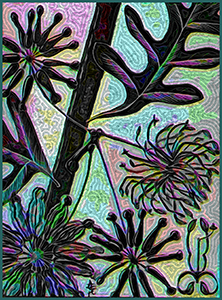
Sources:
Link1: archive.org/details/calgarden1951vol42no2
Link2: archive.org/details/calgarden1952vol43no3
Monday, December 30, 2013
Alfred Hottes I: Professional Illustrations
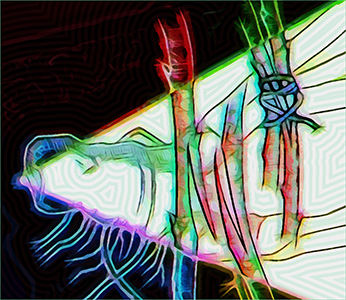
I switch to another library, the California Gardens library in the IA. There was a scientist/artist named Alfred C. Hottes, who lived from 1898 to 1955. His work when he was Professor of Horticulture at Ohio State University was very detailed and expository. Here is an image I made by combining some of the kinky grafting techniques described in Hottes' 1922 Practical Plant Propagation; An Exposition of the Art and Science of Increasing Plants as Practiced by the Nurseryman, Florist and Gardener (Link1). In the center and to the right are three vertical images showing how to cut notches in two twigs from two different trees and bind them up so they grow together. To the left is a drawing of the root system of an Iris, with the plant's body on the left and the roots on the right, used to illustrate the scar produced by a grafting technique.
Sources:
Link1: archive.org/details/practicalplantpr00hottrich
Sunday, December 29, 2013
Microscopic & Photographic Illustration
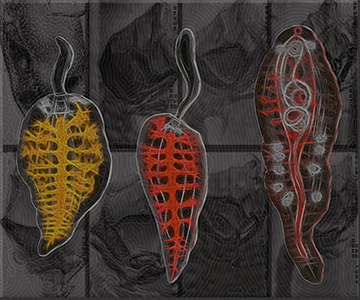
Again from the IA Biodiversity Heritage Library, colored pencil drawings of organisms observed in the 1899 cruise of the steamer "Valdivia", from a 1902 report, Wissenschaftliche Ergebnisse der Deutschen Tiefsee-Expedition (Link1). The drawings are superimposed on an array of photographs from the 1912 periodical, Memoirs of the Queensland Museum (Link2).
Sources:
Link1: archive.org/details/wissenschaftlich1602chun
Link2: archive.org/details/MemoirsQueensla39QueeB
Friday, December 27, 2013
Fossil, Beetle, Plant Cells
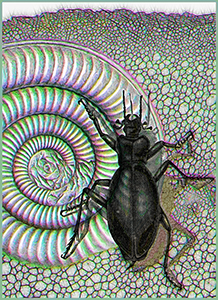
Turning now to another Internet Archive library, the Biodiversity Heritage Library, here's an image composed of three illustrations. First comes a picture of a Carabus beetle from the 1898 A Text-book of Entomology, including the anatomy, physiology, embryology and metamorphoses of insects, for use in agricultural and technical schools and colleges as well as by the working entomologist (Link1). Next to that beetle is a fossil of an extinct ammonite shell from the 1880 Beitrage zur Palaontologie Osterreich-Ungarns und des Orients (Link2). All displayed on an illustration of skin cells from a begonia plant from the 1933 Phytologia (Link3).
Sources:
Link1: archive.org/details/textbookofentomo00pack
Link2: archive.org/details/beitrgezurpal06wien
Link3: archive.org/details/phytologia27glea
Friday, December 27, 2013
Pensive Cinderella
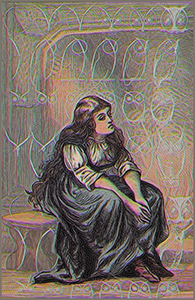
Again from the Internet Archive Children's Library, a collage of two works. One is an illustration from the the Dalziel version of Cinderella (Link1), dated between 1865 and 1889. It shows an unhappy Cinderella stealing a moment from her chores and her wicked stepsisters to ponder her situation. On top of that is a selection of sample drawing techniques from the 1913 What to Draw and How to Draw It by E.G. Lutz, showing the steps to draw an owl.
Sources:
Link1: archive.org/details/cinderella00dalziala
Link2: archive.org/details/whattodrawhowtod00lutz
Wednesday, December 25, 2013
Detail of Two Giants Engraving

Turning to the Internet Archive Children's Library, a work based on a single illustration from the 1851 The Story of Jack and the Giants, showing the faces of two giants at breakfast. The drawings were by Richard Coyle, but the all-important engraving was by the Dalziel brothers. One reviewer summarized the story, "Jack kills evil giants, steals from thieves and gives to the poor, saves damsels in distress, overcomes adversity, gets the girl, and lives happily ever after."
Sources:
Link1: archive.org/details/storyofjackthegi00dalziala
Wednesday, December 25, 2013
Pair of Dancers in a Valley
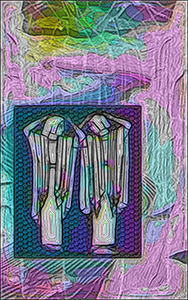
Another one from Project Gutenberg. From the 1911 The Dance (by An Antiquary): Historic Illustrations of Dancing from 3300 B.C. to 1911 A.D. (Link1), a figure of two Greek dancers in a solemn dance, taken from a vase. The book says the ancient Greeks considered dancing a religious rite. The playwright Sophocles is said to have danced after the Greek defeated the Persian Xerxes at Salamis. The pair are set against a line drawing from the 1899 poetry collection Behind the Arras: A Book of the Unseen (Link2).
Sources:
Link1: ia700502.us.archive.org/3/items/thedancebyananti17289gut/17289-h/17289-h.htm
Link2: archive.org/details/behindthearras18242gut
Tuesday, December 24, 2013
Age 69: Dancer/Semaphore/Sailing Ship
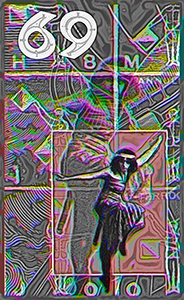
Now from Project Gutenberg, my 69th birthday image. A picture of Russian ballerina (Sophie Federova) from the 1911 The Dance (by An Antiquary): Historic Illustrations of Dancing from 3300 B.C. to 1911 A.D. (Link1). Federova danced ballet until she was 53. She then declined and her obituary said, "She lived quietly between outbursts of consciousness and delirium." Her exuberant image here (she was about 30 at the time) is superimposed on two other images: an illustration from an 1899 poetry collection Behind the Arras: A Book of the Unseen (Link2) and a page of semaphore code from the 1918 The Plattsburg Manual: A Handbook for Military Training (Link3). The big "69" marking my age in the upper right is in Informal011 font... Happy Birthday, self. It is what it is.
Sources:
Link1: ia700502.us.archive.org/3/items/thedancebyananti17289gut/17289-h/17289-h.htm
Link2: archive.org/details/behindthearras18242gut
Link3: archive.org/details/theplattsburgman19552gut
Monday, December 23, 2013
Medical Mother Goose
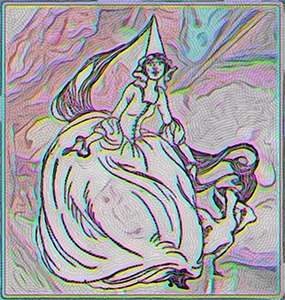
Also from the "Community Texts" library at the Internet Archive, a pen drawing of a simple medieval Mother Goose from a 1922 children's anthology, The Latch Key of my Bookhouse (Link1). The childlike image is superimposed on a rather grisly but colorful photograph from a 2010 medical text, Textbook of Procedures in Obstetrics and Gynaecology (Link2). The finger of a blue rubber glove is visible at the top center, pressed against a scalpel. The procedure is dissection of a female bladder.
Sources:
Link1: archive.org/details/thelatchkey01millarch
Link2: archive.org/details/TextbookOfProceduresInObstetricsAndGynaecologyTextbook-UniversityOf
Sunday, December 22, 2013
A Scotsman's Pewside Memories
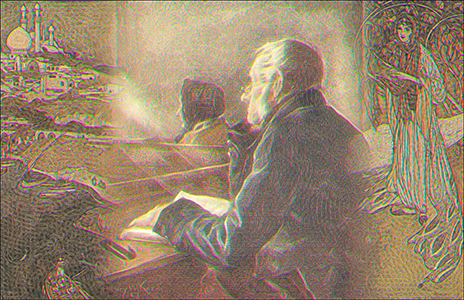
Yet another stop on my Public Domain Cull Route, I stop by the "Community Texts" library at the Internet Archive, formerly known as the "Open Source Library." This image shows a painting of an old Scotsman sitting piously in church, from the 1908 Reminiscences of Scottish Life and Character (Link1). On either side are his old man's memories of life in another place -- illustrations from a 1907 copy of Arabian Nights by Laurence Housman (Link2). On the left side is the island city of Deryabar, the site of a dizzying tale of bloody court intrigue. On the right side is the well-read Schezerade... All this is relevant to my life because tomorrow is my 69th birthday, which makes me pretty damn old. Although I don't spend much time reminiscing, the production of these images, most from the historical past, may be my own form of an old man's sad revery of past glories.
Sources:
Link1: archive.org/details/reminiscencesof00ramsmiss
Link2: archive.org/details/storiesarabian00housmiss
Sunday, December 22, 2013
Perpetuum Mobile
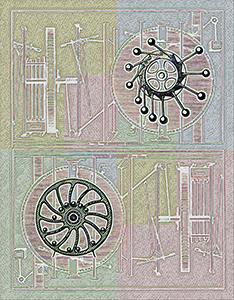
More collaged images from the 1913 Physics for Entertainment (Link1), showing three different perpetual machines proposed over the years. In the background, are two copies of an early 18th century machine by Orffyreus, a con man who lived well for decades demonstrating the complicated machine to European nobility. Russia's Peter the Great was one of the people interested in buying it. The machine was a fraud, turned by a hidden confederate. At the bottom left is a wheel with compartments containing weighted balls. The theory is that the falling motion of the balls will keep the wheel turning. At the top right is a medieval perpetual motion device with hinged weights on sticks that serve to keep the wheel turning. None of them worked... For a brief period when I was a boy I imagined that I had invented a perpetual motion machine, a windmill-type instrument that had tubes on each sail that used the Venturi Effect to speed up the rotation. After an excited night imagining world domination, I explained the idea the next morning to my schoolteacher father, who explained why it wouldn't work. Typical Bob. Quiet and shy, but inside my head there are Walter-Mitty-like visions of grandeur, such as Predicto, my stock market forecasting program. This current series of art works may be another of these quiet, internal hallucinations that provide me such satisfaction.
Sources:
Link1: archive.org/details/physicsforentert035428mbp
Saturday, December 21, 2013
Reflection Pattern in Bird's Nest
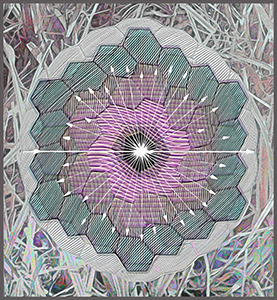
Turning to another stop on my tour of Public Domain outlets, I drop by the academic-oriented Universal Library (also known as the Million Books Project). The central image is from the immensely entertaining 1913 Physics for Entertainment (Link1) by a Russian physicist (who died with so many others in the Siege of Leningrad); it explains the "Palace of Illusions" in the 1900 Paris World's Fair, which was "like the inside of a huge rigid kaleidoscope." Placed on top of that distorted stack of hexagons is an illustration from the 1956 Elements Of X Ray Diffraction (Link2), a circle of white arrow vectors showing scattering by an atom. The scientific graphic quality of these images tends to lead to sterile results. To counteract this, I go back to an image from an earlier collection from the American Library, the 1914 The Bird Book(Link3), a picture of a sparrow's nest.
Sources:
Link1: archive.org/details/physicsforentert035428mbp
Link2: archive.org/details/elementsofxraydi030864mbp
Link3: archive.org/details/birdbookillustra00reedrich
Saturday, December 21, 2013
Spider Composition: Lattice, Cocoon, Mating
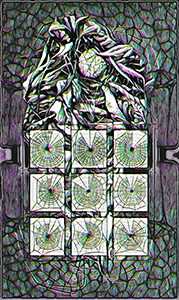
Three collaged images from one of the volumes (I'm not sure which one; sloppy paperwork on my part) of the multi-volume 1889 American Spiders and their Spinningwork: A Natural History of the Orbweaving Spiders of the United States (Link1). One (center) shows a spider family's different web designs built on a nine-window laboratory lattice; the second (top) shows a perfectly spherical cocoon nestled in foliage and wrapped in webbing; and the third, in the background, barely visible, shows two spiders "pairing" in their web. All you can see of the two love-making arachnids is their skinny legs at top and bottom.
Sources:
Link1: archive.org/details/americanspiderst01mccouoft
Friday, December 20, 2013
Butterfly with Spider Web
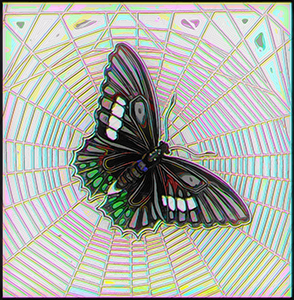
Now, from the Internet Archive's Canadian Library collection, two superimposed images: (1) from the 1832 Book of Butterflies, Sphinxes and Moths (Link1), an Anchises butterfly, a native of Surinam -- somewhat recolored in my digital rendering -- is superimposed on an illustration from the 1889 American Spiders and their Spinningwork: A Natural History of the Orbweaving Spiders of the United States (Link2), showing the distinctive web of the Argiope spider with its "beribboned hub." I prefer to think the butterfly will survive the entanglement.
Sources:
Link1: archive.org/details/bookofbutterflie01browuoft
Link2: archive.org/details/americanspiderst01mccouoft
Thursday, December 19, 2013
FLWRZ
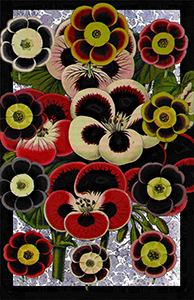
From the Internet Archive's American Library collection, two superimposed images from Volume 5 (Link1) of a large Belgian/French series of nature books, La Belgique Horticole: in one, a series of new varieties of flowers from the Primrose family, and in the second, a bunch of geraniums.
Sources:
Link1: archive.org/details/labelgiquehortic05lige
Thursday, December 19, 2013
Octopus on Baobab Tree
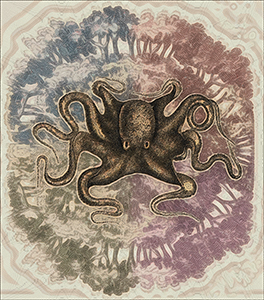
From the Internet Archive's American Library collection, two superimposed images from Volume 9 of an 1859 Belgian/French series of nature images, La Belgique Horticole: in the center, an Octopus, placed on a field of a mirrored baobab tree.
Sources:
Link1: http://archive.org/details/belgiquehorticol09lige
Wednesday, December 18, 2013
Seed Development
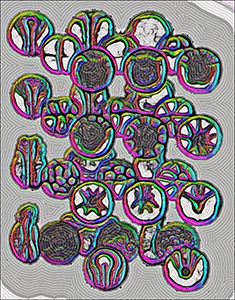
Last one from this month's Gallica public domain feed, a collage of three illustration from Boris Rybak's 1968 German book Psyche, Soma, Germen, a book of zoophysiology. I wasn't able to find an English translation, but Rybak is a philosopher and poet and the book's title refers to the subject of the mind/body/soul connection.
Sources:
Link1: gallica.bnf.fr/ark:/12148/bpt6k6567802t
Wednesday, December 18, 2013
Japanese Porn
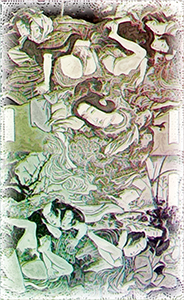
Again from the French Gallica public domain site, a collage of five illustrations from an 1822 Japanese book of pornography Keichu kibun: Makura bunko (Link1), with engravings by ukiyo-e artist Keisai Eisen. I love the overwhelming detail and texture of these pictures, which show actual pubic-haired genitals in varied couplings, surrounded by all the physicality of fabric, vases, and plants. A relief from the airbrushed oversimplification of Western porn... In eighth day of cold, cough gone but weak, trying to resume daily life.
Sources:
Link1: gallica.bnf.fr/ark:/12148/btv1b525032451
Tuesday, December 17, 2013
Cooking Up
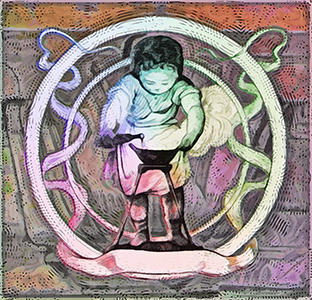
Via the French Gallica public domain site, an illustration from an 1887 book Promenade d'une fillette autour d'un laboratoire by Gouzy (Link1), showing a young girl pouring a bottle of liquid into a steaming laboratory pan on an iron tripod. Most of my work here was in adding color... In seventh day of cold, still have a cough.
Sources:
Link1: gallica.bnf.fr/ark:/12148/bpt6k6567174w
Monday, December 16, 2013
Three Medieval Men
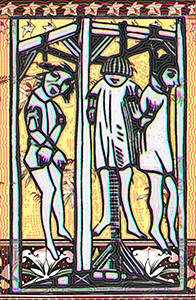
Returning from a period of drift in my artistic purpose, back to the whimsical process of discovery and mystery. From the French Public Domain site, gallica.org, an image from an 1872 book on engraving, Traite elementaire et pratique pour apprendre a graver sans maitre (Link1). The figure is used as an example of woodcut technique -- and a fine woodcut it is! It seems to be a grisly image of three hanged men, captioned "Figure Tiree du Parement et Triomphe des Dames d'honneur," a 15th-century work by courtier and poet Olivier de la Marche. A modern research paper in PDF form gives a sense of the chivalric content of the Parement:
"The poem basically contains a list of the virtues that should be possessed by the ideal lady, and these virtues are symbolised by the various components of her dress. This concept develops the idea that a person can be 'armed with virtue' as seen in some of his earlier works. Thus the blouse of the lady represents the virtue of honesty, the corset chastity, the slippers humility, the laces loyalty, the hatpin patience, the purse liberality, the ring faith, the gloves charity, the ribbon fear of God, and so on."The woodcut is placed on a wallpaper design from an 1873 Histoire d'une maison, by architect Eugene Viollet-le-Duc (Link2).
NOTE:
Two upcoming events will impact philly-bob.net followers.
I recently traveled to New York City and took a number of photos at museums and for a while, instead of public domain images, I will be processing those on a different web page called Philly-Bob's Museum Images. This may later be changed to a travel page. Here are some resulting images:
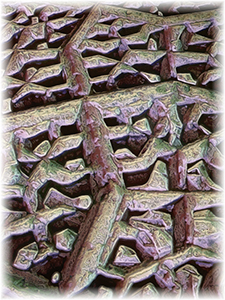
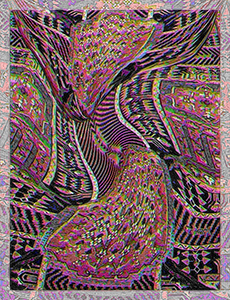
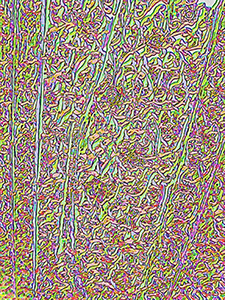
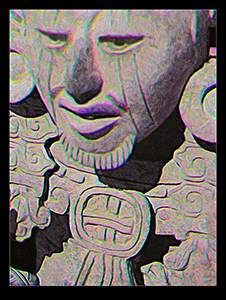
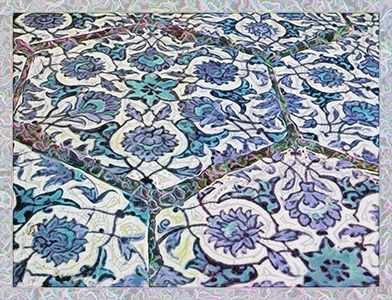
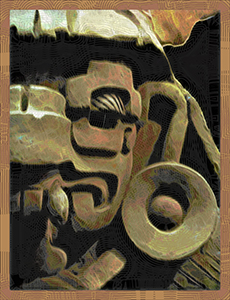
Also, as 2013 ends, I will have to clean out my online directories for 2014. When I do, you'll have to go through a different web address to access my 2013 images, just as you do for my 2012 work.
Enigmatic Scene in Iceland
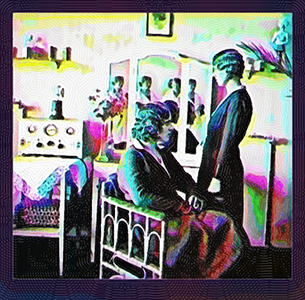
From Flickr's Reykjavik Museum of Photograph, a 1930's photo (Link1), captioned only "tvær stúlkur á hárgreiðslustofu." It stuck me as a bit scary, like women after lobotomies. But Google Translate tells us that it's just "Two girls in a hair salon," apparently showing off their new "bobbed" hair styles. I hope the false-colorizing heightens the spooky character of the image.
For maximum effect with my images, click on the image until it is full-size, which may be larger than your computer screen.
Sources:
Link1: www.flickr.com/photos/reykjavikmuseumofphotography/8076834255/
Femme Fatale of the early 20th Century
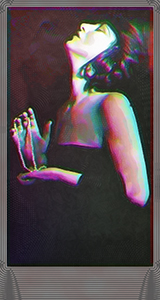
From Flickr's Museum of Photographic Arts, a 1920 photo (Link1) by Orval Hixon of Evelyn Nesbit Thaw, then 36-years-old, a stage beauty who was involved in a famous scandal. According to Wikipedia, an obsessed husband took her on a cultish tour of European sites dedicated to virgin martyrdom that ended in her brief sexual imprisonment in a castle. The same husband later murdered romantic rival Stanford White, a Beaux-Arts society architect, which led to the "Trial of the Century."
For maximum effect with my images, click on the image until it is full-size, which may be larger than your computer screen.
Sources:
Link1: www.flickr.com/photos/mopa1/5711528268/
Opera Singer against Wind Tunnel
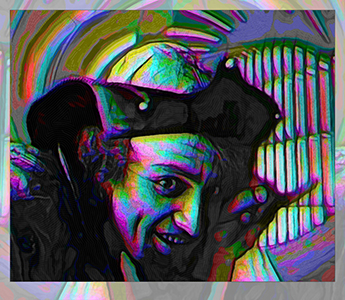
From Australia, a 1911 photo (Link1) of baritone Anafesto Rossi playing the title role in Verdi's opera Rigoletto, set against a 1950 photo (Link2) of a 19-foot NASA Pressure Wind Tunnel in Langley, Virginia.
For maximum effect with my images, click on the image until it is full-size, which may be larger than your computer screen.
Sources:
Link1: www.flickr.com/photos/statelibraryofnsw/4684553742/
Link2: www.flickr.com/photos/nasacommons/7598845286/
Republishing the following in honor of the massive Ukrainian street protests, demanding their government break free from Russia and ally with Europe:
Ukrainian Heroines
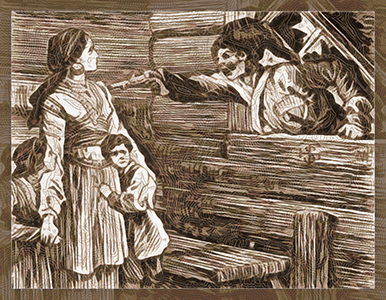
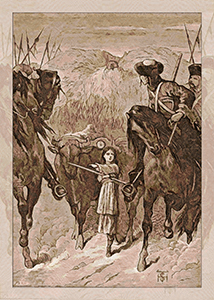
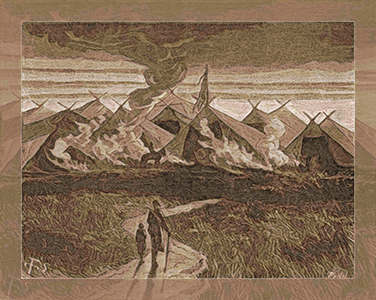
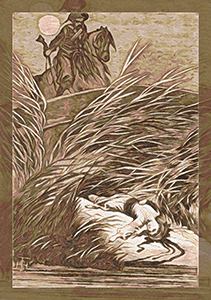
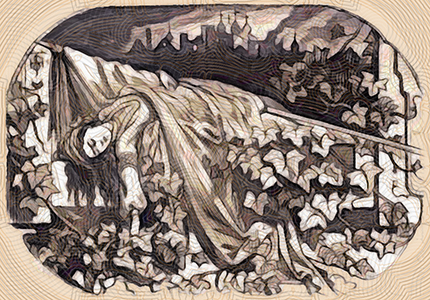
Illustration from an 1878 children's book Maroussia: A Maid of the Ukraine (Link1), telling a Ukrainian legend. It is a charming story of a little girl who gives her life to rescue The Envoy, a George Washington-type national hero, during a period of political turmoil (when the Ukraine was invaded by Russia, and was considering whether to ally with Poland or go independent). Here, the girl's mother does a masterful job of stalling Cossacks who want to arrest the Envoy, a guest at their house. One pistol-wielding Cossack breaks a window to demand that the mother open the door or he will burn the house down. Cunning, the fearless mother plays stupid -- oh my goodness, I lost the key, I know it's in here somewhere. I'm so confused. Think Edith Bunker in All in the Family. The delaying tactic gives the Envoy time to escape. The little girl on the left, whose hand is being grasped by her mother, is the heroine Maroussia. After the Envoy is gone and mother lets the Cossacks in, Maroussia slips outside and leads the Envoy through the battle-scarred steppes to his destination. That journey, their adventures together, and the stories they tell each other, form the legend's key narrative. I'm reading the English translation.
In the second picture: during their journey, the plucky 11-year-old heroine hides the Envoy in an oxen wagon loaded with hay to smuggle the fugitive past the cossacks hunting him. But when the cossacks stop the wagon and begin to question her, quick-witted Maroussia charms her way out of it. The soldier guarding the wagon ask Maroussia where her parents are, but she turns it around, asking the soldier about his family, getting him to tell her about his own daughter, who is about the same age as Maroussia. Distracted, he doesn't search the wagon, doesn't find the Envoy hiding in the hay.
The third picture shows Maroussia and the Envoy arriving at a camp, their journey done.
After the Envoy is safely delivered, Maroussia is killed by a Tartar's stray bullet and is laid out on a funeral bier, where she is mourned by all. Not a dry eye in the house.
(gallica-1108)
Link1: http://gallica.bnf.fr/ark:/12148/bpt6k65518515
Enjoying Icicles at Australian Resort
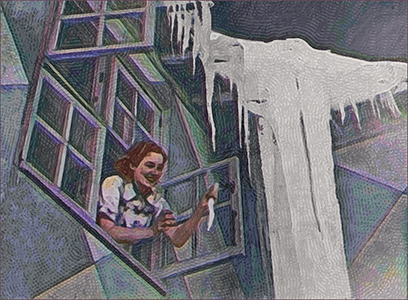
From the Flickr Commons collection of the State Library of New South Wales, a photo (Link1) from the 1930's of a vacationer smiling as she looks out the window of the ice-covered Kosciuszko Chalet, a famous inn at the Charlotte Pass, the highest point in Australia. The photographer was Sam Hood.
For maximum effect with my images, click on the image until it is full-size, which may be larger than your computer screen.
Sources:
Link1: www.flickr.com/photos/statelibraryofnsw/7398060460/
Ballerina against Falls
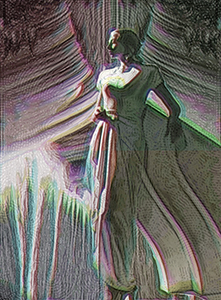
More compositions based on material in the Flickr Commons. A 1947 studio portrait (Link1) of Australian ballerina Pamela Bromley-Smith from the State Library of New South Wales, set against an 1869 photo (Link2) from Canada's McCord Museum, showing the Rideau Falls in Ottawa. The picture of the Falls is tipped 90-degrees, duplicated, and then flipped horizontally.
For maximum effect with my images, click on the image until it is full-size, which may be larger than your computer screen.
Sources:
Link1: www.flickr.com/photos/statelibraryofnsw/6345523499/
Link2: www.flickr.com/photos/museemccordmuseum/2918568397/
Unidentified Australian Woman
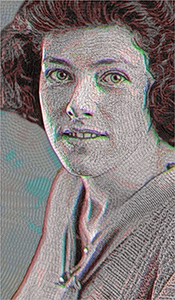
The Flickr Commons collection of the Australian National Maritime Museum includes the collection of professional photographer William Hall, 1877-1951. Many of the portrait subjects are unidentified, including this undated photo of a young woman, which I imagine was a keepsake for some sailor. The subject has the look of so many bright-eyed Irish girls of my youth. My technique is developing quickly. I call this technique (in my personal shorthand) GIMP:Contours/Edge-offset, PS:Remove White, PS: Stroke. The image was originally much larger, 2700 x 3600 pixels, and this recoloring/retexturing represents just a small piece of the portrait.
For maximum effect with my images, click on the image until it is full-size, which may be larger than your computer screen.
Sources:
Link1: www.flickr.com/photos/anmm_thecommons/8556528314
WWI German U-Boat Control Panel
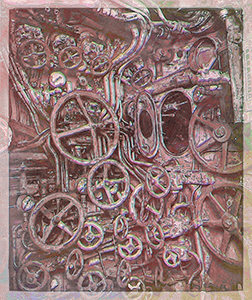
From the Flickr Commons collection of the Tyne & Wear Archives & Museums in England, a photograph of UB-110, a German submarine captured by the British in 1918. 110 must be an unlucky nuber: in World War II, a German U-110 was also captured; that 1942 capture led to the breaking of the Enigma code; the story is told in the movie U-571. This image represents a colorizing and "texturizing" (a term I'm using for the first time) of the original black-and-white photo. Other U-110 images can be seen here.
For maximum effect with my images, click on the image until it is full-size, which may be larger than your computer screen.
Sources:
Link1: www.flickr.com/photos/twm_news/8770687732/
Crowd Scene
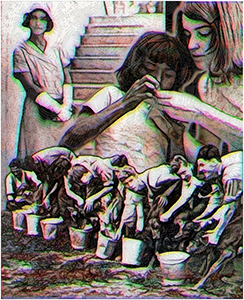
Three combined pictures from various collections at the Flickr Commons. At bottom, from the photographic collection of New South Wales, a photo (Link1) of a group of boys feeding calves at a training farm. Above that, from the photographic collection of the Mennonite Church, a photo (Link2) of a Girls' Club leader showing a Puerto Rican student how to sew. And, at left top, again from New South Wales, a photo (Link3) of a clerk in ladylike white gloves from Sydney's Public Works Department, standing next to the Sydney Harbor Bridge.
For maximum effect with my images, click on the image until it is full-size, which may be larger than your computer screen.
Sources:
Link1: www.flickr.com/photos/state-records-nsw/2676420870/
Link2:
www.flickr.com/photos/mennonitechurchusa-archives/5590379816/
Link2:
www.flickr.com/photos/state-records-nsw/5577548717/
Raya in Gypsy Dance
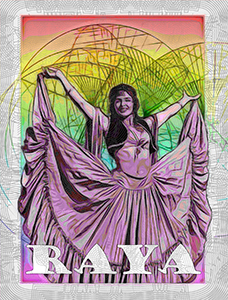
From the Flickr Commons section from the National Archives of Norway, a 1972 picture (Link1) of young Raisa ("Raya") Bielenberg/Udovikova, a Romani (Gypsy) actress and performer. She was born 1943 in a Russian Gypsy camp. She lives and performs in Norway, where she is called a "Gypsy Icon." Some of her later performances can be seen online. She also appeared in movies. She has a daughter, Natasha Bielenberg, who also
performs. In the picture above, Raya's exuberant grace is posed against a construction drawing of the Sydney Opera House (Link2). The font is Frederick Goudy's Goudy Stout, designed in the 1930's, recut by Microsoft.
For maximum effect with my images, click on the image until it is full-size, which may be larger than your computer screen.
Sources:
Link1: www.flickr.com/photos/national_archives_of_norway/5577277237/
Link2:
www.flickr.com/photos/state-records-nsw/5454015005
Suckling Child, Parquet Floor
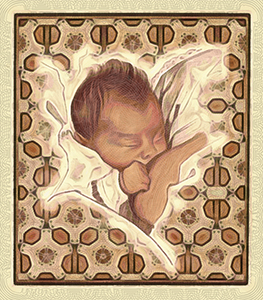
From the Flickr Commons section on the Architecture collection of Het Nieuwe Instituut, a colored-pencil sketch by Dutch Architect Michel de Klerk showing his thirteen-day-old son Joost suckling at his mother's breast (Link1). The picture is overlaid on a design (Link2) for a parquet floor by H.P. Berlage, a design said to be inspired by German biologist Ernst Haeckel's book of drawings of microscopic organisms.
For maximum effect with my images, click on the image until it is full-size, which may be larger than your computer screen.
Sources:
Link1: www.flickr.com/photos/nai_collection/6861872440/
Link2: www.flickr.com/photos/nai_collection/8475987080/
Three Actresses in Costumes
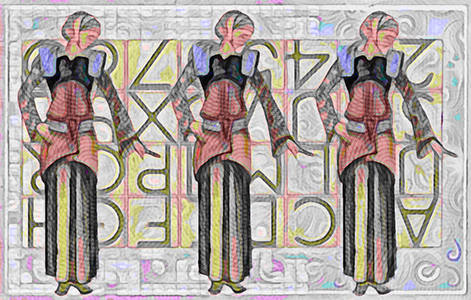
Back to exploring the Flickr Commons, a look at the online offerings of Het Nieuwe Instituut, a Dutch architect's organization. Four elements in this one: the triple girls in the foreground are a costume design (Link1), placed upon an upside-down alphabet (Link2), then arranged on a decorative pattern (Link3) and a floor tile design (Link4).
For maximum effect with my images, click on the image until it is full-size, which may be larger than your computer screen.
Sources:
Link1: www.flickr.com/photos/nai_collection/8475989238/
Link2: www.flickr.com/photos/nai_collection/8474899479/
Link3: www.flickr.com/photos/nai_collection/8474898777/
Link4: www.flickr.com/photos/nai_collection/8475988444/
Arctic Convoy

Philadelphia's Plastic Club is having an exhibition devoted to the subject Weather, so I found a wintry scene in a photo from the Flickr Commons section devoted to images released to the public domain by England's National Maritime Museum. It is a 1942 photo called The Forward Superstructure of HMS Manchester in Arctic Waters. The Manchester was a Royal Navy cruiser engaged in an arctic convoy delivering supplies to the Soviet Union during World War II.
For maximum effect with my images, click on the image until it is full-size, which may be larger than your computer screen.
Sources:
Link1: http://www.flickr.com/photos/nationalmaritimemuseum/6105881358/
Follow-up after opening of Plastic Club's Weather show: Described my working methods to DB, a knowledgeable Plastic Club member attending the opening. He said my method (digital manipulation of public domain images) is sometimes called Post-Postmodernism, or Po-po-mo. Looking up the subject, I find confusing, imprecise abstract "critical theory" seminar. It leaves me cold. I hated (and never understood) Postmodernism. My formal education ended when I dropped out of a Masters Degree program in English Literature around 1969. This was before post-modernism hit midwestern colleges. Afterwards, when I read about post-modernism, I considered it a fraud (like some of the critics referenced here). Since I'm definitely over Postmodernism, perhaps the description fits me. Here's another description of popomo, from an article called "The Place of Postmodernism in Postmodernity":
Nevertheless, these "trans" phenomena want to come to self-expression in the form of repetition. Paradoxically as it may sound, it is precisely through repetition that they reclaim their primacy and authenticity. Tired gestures, which are no longer automatized, as in the poetics of postmodernism, are replete with their own lyricism. In repetition, in quotation, there is a naturalness, a simplicity, an inevitability which is lacking in a primary act, born of effort and with claims to revelation.Sounds like my reuse of old pictures. Anyway, I told DB that the reason I chose my method was because I couldn't draw good anymore and I never understood anything beyond the "A" (Automatic) setting on my camera.
Later: My impression of post-modernism was snotty college bullies who parroted obscurantist ideas from European philosophers (some of them ex-Nazis). Somehow, their critical theories made them feel superior to the works they studied.
I do not feel superior to the works I appropriate (by using them in my work). I respect the craft and artistic intent of those old-timers. I feel I am honoring my ancestors.
Washing Day
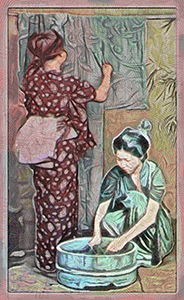
Another one from the National Museum of Denmark section of Flickr Commons. A black-and-white image (Link1) of two Japanese women doing washing, one scrubbing clothes in a tub, the other hanging a kimono on the line. The photo was donated to the Museum in 1925, but probably was taken earlier. I used a variety of techniques to add color.
For maximum effect with my images, click on the image until it is full-size, which may be larger than your computer screen.
Sources:
Link1: www.flickr.com/photos/thenationalmuseumofdenmark/10796577693/
Our Lady of Parasols & Polka Dots
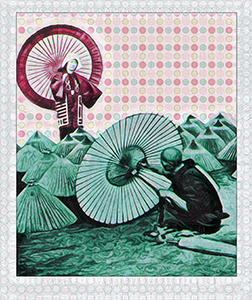
Still exploring the National Museum of Denmark section of Flickr Commons. A surprising find in the Danish photos is a collection of mid 19th-century images of Japan. In one (Link1), an image of a woman in street clothes with an umbrella on her shoulder, collected by painter Karl Madsen. Below, a seated umbrella maker from Kobe, Japan, works on his wares (Link2), copied from an old Danish magazine. The incongruous background is a polka-dot pattern from Photoshop.
For maximum effect with my images, click on the image until it is full-size, which may be larger than your computer screen.
Sources:
Link1: www.flickr.com/photos/thenationalmuseumofdenmark/9097733727/
Link2: www.flickr.com/photos/thenationalmuseumofdenmark/9099970734/
Diplomat's Medals
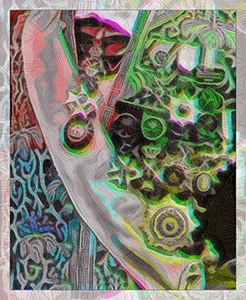
Again from the Flickr Commons, here's an enlarged and colored detail from a 1901 portrait (Link1) of a Japanese diplomat in Copenhagen. It shows his full-uniform chest, with brocade ornament, numerous medals and a sash. It is from the National Museum of Denmark.
For maximum effect with my images, click on the image until it is full-size, which may be larger than your computer screen.
Sources:
Link1: www.flickr.com/photos/thenationalmuseumofdenmark/10797978603/
Art Class, Cops, and Suitcase
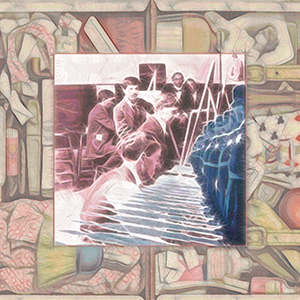
Again from the Flickr Commons, here's a collage composed of pictures from the California Historical Society: left, an 1898 photo (Link1) of a San Francisco, California, art school class, and right, an 1898 photo (Link2) of cops (?) standing at attention as an expedition marches off to the Spanish American War, all placed upon a frame from an advertisement for a trunk store (Link3). Incidentally, although the Flickr Commons promises photos are "free of copyright," the conditions placed upon one Australian historical group (written permission to use) are so onerous that I decided to skip them.
For maximum effect with my images, click on the image until it is full-size, which may be larger than your computer screen.
Sources:
Link1: www.flickr.com/photos/chs_commons/9352700661/
Link2: www.flickr.com/photos/chs_commons/9628801563/
Link3: www.flickr.com/photos/chs_commons/9355803456/
Inside and Outside Restaurant
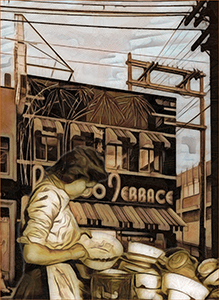
Again from the Flickr Commons of public domain photographs, here's a collage of three photos contributed to the public domain by the Vancouver (Canada) Public Library, the second largest library in Canada. In the foreground is a 1902 photograph (Link1) of a young woman washing dishes. In the background is a street scene circa 1961, showing the Bamboo Terrace Chinese Restaurant in Vancouver (Link2). Finally, barely visible in the sky is a 1902 photo of piled logs from a logging camp (Link3).
For maximum effect with my images, click on the image until it is full-size, which may be larger than your computer screen.
Sources:
Link1: www.flickr.com/photos/99915476@N04/9554678295/
Link2: www.flickr.com/photos/99915476@N04/10046022073/
Link3: www.flickr.com/photos/99915476@N04/9557473590/
Quoth the Raven
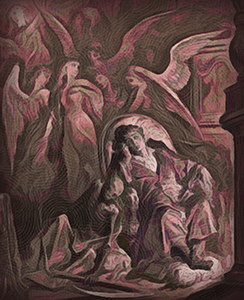
From an 1883 edition of Edgar Allen Poe's The Raven (Link1), here's my digital manipulation of a masterful illustration by Gustave Dore. In keeping with the spooky tone of this poem of regret and loss, I felt a touch haunted by making changes to Dore's illustration: cropping it, recoloring, adding my own treatment. However, Dore got a lot of money from an American publisher for his illustrations, so I expect his ghost will leave me alone. In my own life, I have my own issue of love lost to the grave, but I do not obsess on it "upon a midnight weary" but it comes to me in sudden slaps of remembrance.
(gallica-1111-)
Link1: gallica.bnf.fr/ark:/12148/bpt6k10497704
Orthopedic Treatments
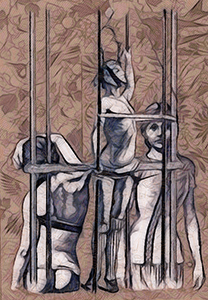
From an 1890 medical periodical, Revue illustree de polytechnique medicale et chirurgicale (Link1), three diagrams of trusses and braces for the treatment of scoliosis. They are superimposed on a decorative pattern from the magazine Animaux, les fleurs, les plantes et leur application a l'art decoratif (Link2), also in 1890. (Apologies to Francophone; as a provincial American, I have never learned how to do linguistic accents.)
(gallica-1111-)
Link1: gallica.bnf.fr/ark:/12148/bpt6k65532895
Link2: gallica.bnf.fr/ark:/12148/bpt6k6559265m
Collage with Island Girl
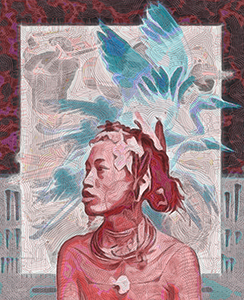
From the 1905 L'homme et la terre (Link1), a survey of life in many countries, a picture of a girl from the South Seas in ceremonial finery shown against, from the same volume, a picture of birds in flight. In the background, a diagram of airplane parts picture from a 1939 magazine, L'aeronautique (Link2) and a display of ancient nails from Aguianine (Link3), a magazine of French provincial archaelogy.
(gallica-1110)
Link1: gallica.bnf.fr/ark:/12148/bpt6k65596472
Link2: gallica.bnf.fr/ark:/12148/bpt6k6554246q
Link3: gallica.bnf.fr/ark:/12148/bpt6k6562358x
Swimmer in Waves
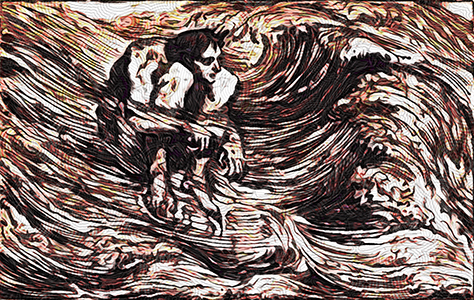
Illustration from L'Art de nager, a 1696 French manual on swimming.
(gallica-1109)
Link1: gallica.bnf.fr/ark:/12148/bpt6k854136j
World War I and the Rape of Belgium
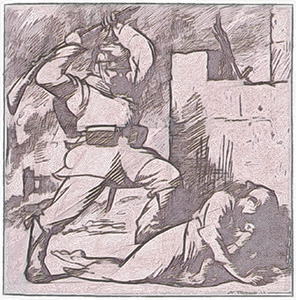
Marking a new direction from the previous year's work, I am now looking at a French public domain site, gallica.bnf.fr. Here, an illustration from a 1915 collection of World War I artists' drawings, from the book La Grande Guerre par les artists (Link1), showing a German beating a Belgian woman and child, part of the intense anti-German propaganda of the time, although it seems that in the early stages of the invasion of Belgium, German soldiers were, indeed, brutal. The drawing is by Auguste Robillon, and is captioned "Heureusement qu'il y a les femmes", which I would translate as an ironic "Fortunately, there were women."
(lastdrops-1106)
Link1: gallica.bnf.fr/ark:/12148/bpt6k65569742
Float Dream: Victorian Home Color Scheme
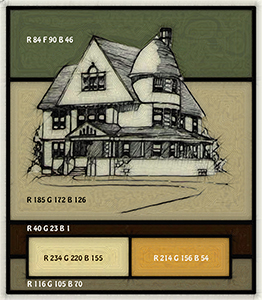
An 1898 paint catalog (Link1).
(lastdrops-1104)
Link1: archive.org/details/PracticalSuggestionsOnExteriorDecoration
Float Dream: Fiji War Clubs, Indian Basket Symbols
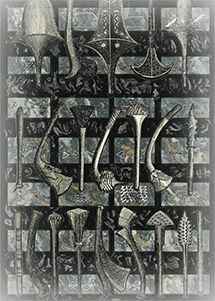
A selection of Fijian war clubs from an 1859 anthropology book, Fiji and the Fijians (Link1), superimposed on a selection of motifs used in American Indian basket-weaving (Link2). Underlying it all is the marblized paper on the inside cover of a 1912 art auction catalog (Link3). This work marks the end of the treatment of the product of my October 2012-October 2013 "Year of Drinking from the Firehose." Not sure what next....
(0930lapkeep-1104)
Link1: archive.org/details/fijifijian00will
Link2: archive.org/details/universityofca02univ
Link2: archive.org/details/cataloguedesdess00unse
Float Dream: Poe's Creepy Berenice

(Click on image to enlarge; may require multiple clicks to enlarge to full size)
From Creepy (Link1), an (undated) horror comic magazine, an illustration showing Edgar Allen Poe's Berenice suffering an epileptic fit. After beautiful Berenice dies, her infatuated cousin, haunted by the memory of her smile, digs her body up and removes her teeth. Happy Halloween! The image, doubled, is laid over a figure from an Arabic book on (I think) architecture on Granada (Link2).
(0924lapkeep-1031)
Sources:
Link1: archive.org/details/granadabahmar
Link2: archive.org/details/warrencreepy-010
Float Dream: Metallic Sheep
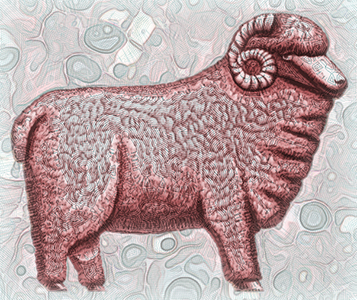
(Click on image to enlarge; may require multiple clicks to enlarge to full size)
From a 1904 catalog of barn equipment, Practical Stable Fitters (Link1), a neat weather vane showing a Merino Ram, set against a marblized book cover.
(0922lapkeep-1030a)
Sources:
Link1: archive.org/details/PracticalStableFitters
Float Dream: Colorized King Lear
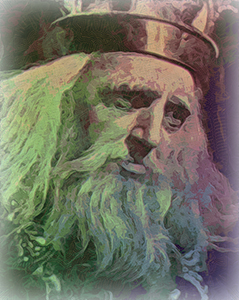
(Click on image to enlarge; may require multiple clicks to enlarge to full size)
From a 1952 issue of the British magazine Theatre World(Link1), a publicity photo of Stephen Murray playing the Shakespearean role of King Lear. Experimenting with various methods of adding color to black & white images.
(0922lapkeep-1030)
Sources:
Link1: archive.org/details/TheatreWorld41952UKk
Float Dream: Mexican Calendar Stone in Different Contexts
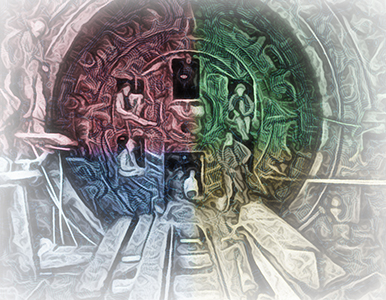
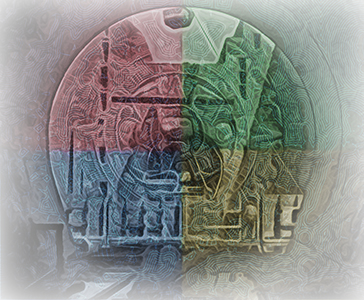
(Click on image to enlarge; may require multiple clicks to enlarge to full size)
From a 1909 book, Fernando Cortes and the conquest of Mexico, 1485-1547 (Link1), an old Mexican calendar stone, set into two entirely different contexts, barely visible in either. In the left image, it is put into a tunnel-digging scene (the Brooklyn-Battery Tunnel) from a 1908 New York travel book (Link2); in the right image the calendar stone is put into a culvert under construction during the building of the Pamama Canal, as shown in a 1913 book (Link3).
(0920lapkeep-1028)
Sources:
Link1: archive.org/details/fernandocortesc00macn
Link2: archive.org/details/velknewyorkgreat00voja
Link3: archive.org/details/panamacana00hask
Birthday Calendar
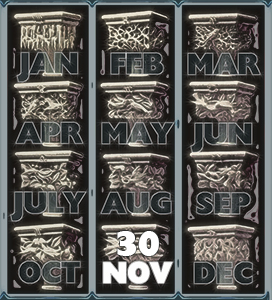
(Click on image to enlarge; may require multiple clicks to enlarge to full size)
From a 1909 book, The story of New Netherland : the Dutch in America (Link1), a display of twelve building columns from a Dutch building in Schenectady, NY, repurposed here to serve as a birthday record. Here, marking my buddy Jim's birthday of November 30. Each column represents a different month, with icicle carvings in January, etc.
(0920lapkeep-1028)
Sources:
Link1: archive.org/details/storyofnewnethe00grif
Float Dream: Building Boston Docks
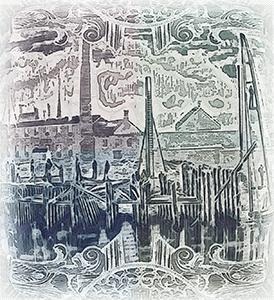
(Click on image to enlarge; may require multiple clicks to enlarge to full size)
From an 1895 book A half century of Boston's building: the construction of buildings, workmen climb around pilings as they build a wharf (Link1). Material at top and bottom are a carved column and a mounted thermometer, distorted beyond recognition.
(0917lapkeep-1027a)
Sources:
Link1: archive.org/details/halfcenturyofbo00damr
Float Dream: 40's Housewife Opens Window
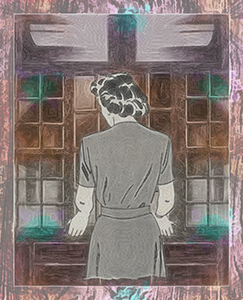
(Click on image to enlarge; may require multiple clicks to enlarge to full size)
From a 1950 catalog of home designs by Brosco (Link1), a housewife demonstrates the ease of opening a window. Her picture is placed on a collage of windows from a 1954 price list of Huttig Sash & Door of St. Louis (Link2). Color comes from an overlay taken from a 1954 Sears wallpaper catalog (Link3).
(0910lapkeep-1021)
Sources:
Link1: archive.org/details/BroscoBookOfDesigns
Link2:archive.org/details/HandyHelperNo.740
Link3: archive.org/details/GuaranteedRoomDecorationWithHarmonyHouseWallCoverings
Float Dream: Another Maid in Kitchen
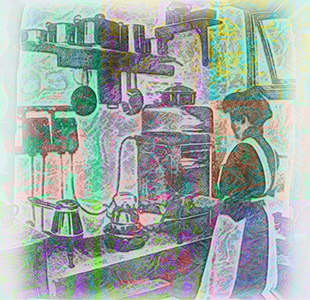
(Click on image to enlarge; may require multiple clicks to enlarge to full size)
Continuing the maid theme, from a 1917 English home economics book, The Labour Saving House (Link1). It shows, according to its caption, an electrical kitchen of a small flat. The image is provided by The British Electrical Transformer Co. "All lifting and stooping is avoided," says the text.
(0908lapkeep-1020)
Sources:
Link1: archive.org/details/laboursavinghous00peel
Float Dream: Maid with Utensils
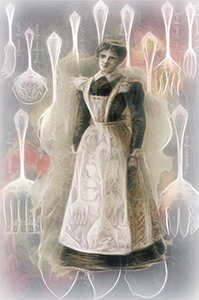
(Click on image to enlarge; may require multiple clicks to enlarge to full size)
From an 1899 Hostess of Today (Link1), a picture of a maid, superimposed on a layout of fancy eating utensils, with color added by an illustration from a pottery magazine Keramic Studio from the same year (Link2).
(0908lapkeep-1019)
Sources:
Link1: archive.org/details/hostessoftoday00larn_0
Link2: archive.org/details/KeramicstudioV
Float Dream: Noah's Ark and Falcon Claw
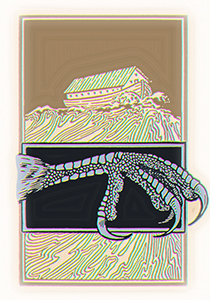
(Click on image to enlarge; may require multiple clicks to enlarge to full size)
Noah's Ark rides on the waves, in a cover of a book, Noah's Grandchildren (Link1), on folk traditions in Georgia. Superimposed below, a drawing of a falcon claw from a section on the local custom of falconing.
(0905lapkeep-1017)
Sources:
Link1: archive.org/details/noahsgrandchildr00chev
Float Dream: Early Aerial View with Tulips
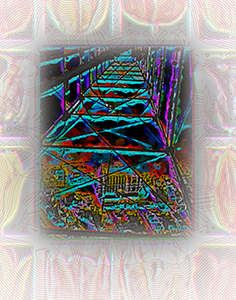
(Click on image to enlarge; may require multiple clicks to enlarge to full size)
In the central panel is a view from one of the earliest flights, in an airship, flying over Paris' Reims Cathedral. You can see the primitive fuselage made of wood and wire. The image, from the program for a 1910 Aeronautical Exhibition (Link1) is drastically manipulated with false RGB color. The central panel is placed in a frame composed of tulips from a 1929 seed catalog. Again, I use false color from a Gimp contour filter called Gradient RGB. (Link2).
(0903lapkeep-1012)
Sources:
Link1: archive.org/details/rapportofficiels00expo
Link2: archive.org/details/farquharsautumnc19rjfa_19
Float Dream: Dancing Girlish
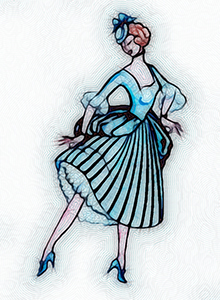
(Click on image to enlarge; may require multiple clicks to enlarge to full size)
From a Smithsonian collection of Americana (Link1), a Joyce Dennys drawing for the cover of a script for Goody Two Shoes, called a "Basic Pantomime in Three Acts" by Trudy West. Dennys was a painter and illustrator who apparently had a job in the 1950's doing covers for scripts published by the drama publishing company Samuel French.
(0903lapkeep-1012)
Sources:
Link1: archive.org/details/xcollection1404A
Float Dream: Night-time Fear
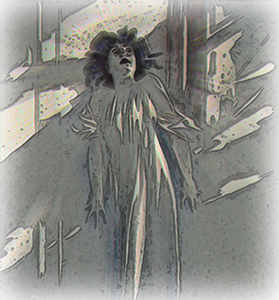
(Click on image to enlarge; may require multiple clicks to enlarge to full size)
A horrified woman backs against a wall, in an illustration by Aleardo Villa for Sorridente!, a 1905 book by Riccardo Sonzogno, published in Milan (Link1).
(0902lapkeep-1011)
Sources:
Link1: archive.org/details/sorridente00sonz
Float Dream: Love in the Streets of Paris
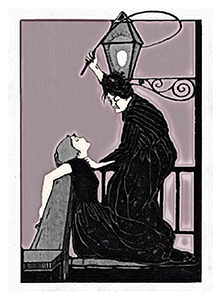
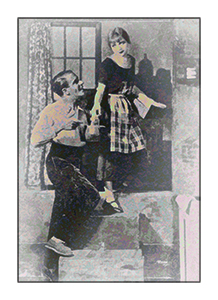
(Click on image to enlarge; may require multiple clicks to enlarge to full size)
On the left, the cover of a book based on a 1922 play, 7th Heaven, included in a Library of Congress Collection of miscellaneous pamphlets (Link1). It tells the love story of a sewer worker and a woman of the Parisian streets -- by implication, a prostitute. The cover shows the heroine, Diane, being beaten by her absinthe-addicted older sister. When police threaten to arrest Diane, she is rescued by the hero, Chico, who tells the police that Diane is his wife. To fool the police, the two move in together -- and fall in love. Chico goes off to fight in World War I. Missing, he is presumed killed and in the final scene, Diane agrees to marry a rich admirer -- until Chico arrives. The story has a strong religious motif. Chico is a confirmed atheist, complaining that God does not answer his prayers. But the audience learns that his prayers are answered, although Chico does not admit it. The play ran on Broadway for 700 performances and was also made into two movies. To the right, a production shot from the a script of the play (Link2).
(0902lapkeep-1009)
Sources:
Link1: archive.org/details/xcollection1371
Link2: archive.org/details/seventhheaven00strorich
Float Dream: Bee Eater
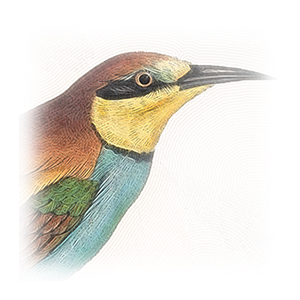
(Click on image to enlarge; may require multiple clicks to enlarge to full size)
From an 1837 book on the Birds of Europe (Link1), a color engraving of a Bee Eater (Merops Apiater), which migrates around the warmer areas of the Mediterranean and even on occasion crosses the English Channel.
(0830lapkeep-1008)
Sources:
Link1: archive.org/details/birdsEuropeIIGoul
Float Dream: Molten Metal Face in Museum
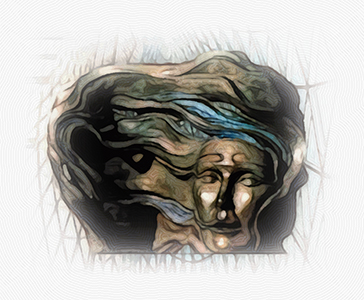
(Click on image to enlarge; may require multiple clicks to enlarge to full size)
From a magazine on interior design (Link1), a sculpture of a face with billowing hair. It is superimposed on a photo from a book showing the British Museum (Link2).
(0830lapkeep-1007)
Sources:
Link1: http://archive.org/details/interior_designconstruction_2005
Link2: archive.org/details/norman_foster_and_the_british_museum
Float Dream: Illusory Woman in Victorian Frame
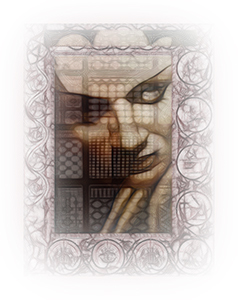
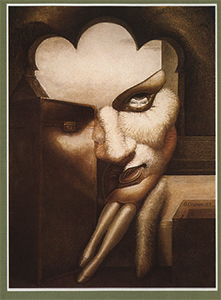
(Click on image to enlarge; may require multiple clicks to enlarge to full size)
Left image is my digital re-creation: the central picture is taken from a collection of optical illusions by neuroscientist Al Seckel (Link1). It is an image by Mexican artist Octavio Ocampo, shown without digital manipulation at the right. At one mental angle (the tubular objects are fingers), it shows actress Marlene Dietrich; at another mental angle, it shows a woman in a fur coat, legs tucked under (the tubular objects are legs, her face is in the right eyeball). That image is laid into a frame from a book on Victorian house designs (Link2); under the face, dimmed in the background, is another image from that same book, showing some tile patterns.
Right image is the original optical illusion.
(0827lapkeep-1006)
Sources:
Link1: archive.org/details/Incredible-Visual-Illusion
Link2: archive.org/details/Victorian_Houses_and_their_Details
Float Dream: Magic Garage Door
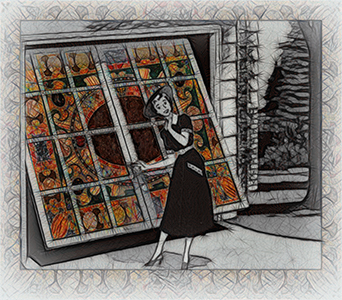
(Click on image to enlarge; may require multiple clicks to enlarge to full size)
A mid-20th-century lady opens the garage door with ease, in a picture from a hardware catalog. Panels of the door are filled with picture from a highly-detailed inlaid wood table from Old Europe.
(0824lapkeep-1001)
Sources: TBA
Float Dream: Unfortunate Brother & Sister
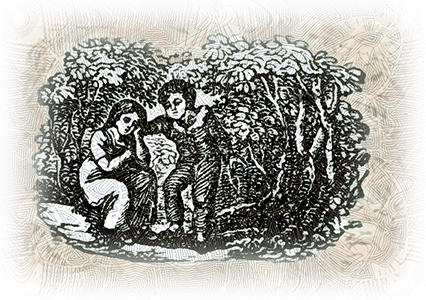
(Click on image to enlarge; may require multiple clicks to enlarge to full size)
Illustration from another old chapbook (dated 18--?) called Children in the Wood (Link1), which tells the story of two children murdered by an evil uncle for their inheritance. They are abandoned in the forest. "Poor children!," says the book's title page, "How they must have cried when in that horrid wood -- How keen their sufferings too, have been, To die for want of food!"
(0820lapkeep-0928)
Sources:
Link1
Float Dream: Jack and Jill

(Click on image to enlarge; may require multiple clicks to enlarge to full size)
An 1830 chapbook depiction of Jack and Jill, from the traditional English nursery rhyme about the two (probably brother and sister) "who went up the hill to fetch a pail of water...", etc.
(0820lapkeep-0926)
Sources:
Link1
Float Dream: Escape from Prison
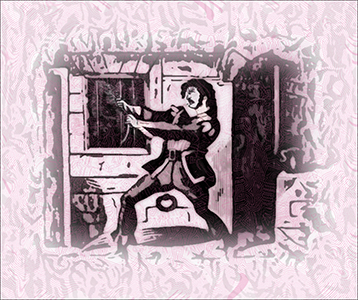
(Click on image to enlarge; may require multiple clicks to enlarge to full size)
A famous turn-of-the-century criminal esapes from prison by bending the bars of his cell window, from an old chapbook.
(0811lapkeep-0925)
Sources: TBA
Float Dream: Woodcut Lady
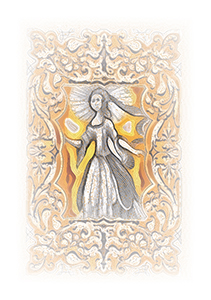
(Click on image to enlarge; may require multiple clicks to enlarge to full size)
After considerable experimentation to find a suitable style for old woodcut and chapbook illustrations, here's a picture of a floating lady, from an undocumented source. Note the attempt to fade the image, rather than frame it. You can see the experiments on the rejects page.
(0811lapkeep-0923)
Sources: TBA
Composition: Japanese Architect's Drawing

(Click on image to enlarge; may require multiple clicks to enlarge to full size)
A digital manipulation of a plan in a book titled Japanese Temple Design Rules (Link1), dating from approximately 1200, full of architects' drawings for Zen and Samurai temples. The book was found in a used book store and uploaded to Internet Archive by the buyer.
(0801lapkeep-0918)
Sources:
Link1
Dream Vision: Color Wheelies and Plants
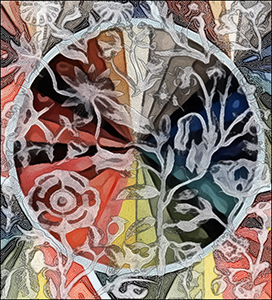
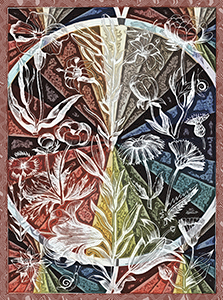
(Click on image to enlarge; may require multiple clicks to enlarge to full size)
From Armstrong's 1949 catalog, five duplicates of a color wheel showing shades available in the company's plain linoleum product (Link1). Superimposed on top of that is a crowded page of flower drawings from the French Livres de Fleurs (Link2), done approximately 1700. I am fond of this image, so I did it larger (right) and sent both versions off to Poster Print Factory for poster prints, the first 12"x13.2" and the second 18"x24", total cost a little over $30.
(0730lapkeep-0916)
Sources:
Link1,
Link2
Dream Vision: Fool on the Hill
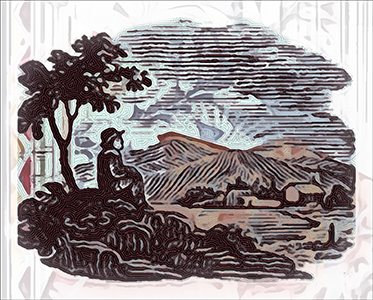
(Click on image to enlarge; may require multiple clicks to enlarge to full size)
Another old woodcut: a man sits on a hill contemplating a sunset. Again, the image is overlaid on a couple different linoleum patterns, cut in a zigzag pattern.
(0726lapkeep-0915)
Sources: TBA
Dream Vision: Girl, Weave, Linoleum
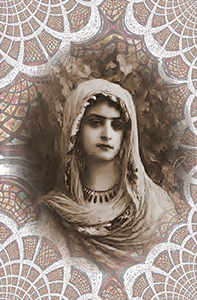
(Click on image to enlarge; may require multiple clicks to enlarge to full size)
Painting of a young woman, superimposed on a curious combination of weaving patterns and linoleum, digitally manipulated with a fractal computer algorithm.
(0724lapkeep-0912)
Sources: TBA
Dream Vision: The Descent
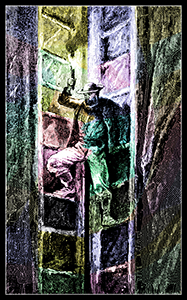
(Click on image to enlarge; may require multiple clicks to enlarge to full size)
Eperimenting with extra-large image created by using Aibek's enlargement method. Picture from Scribner's of a miner descending down a ladder.
(0905pkeep-0906)
Sources: TBA
Dream Vision: Interesting Items
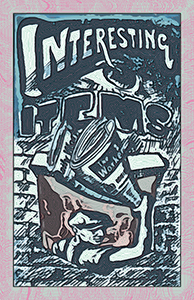
(Click on image to enlarge; may require multiple clicks to enlarge to full size)
From a miscellaneous "X-Collection" folder (Link1) of "amateur journalism" recently uploaded by the Smithsonian, the cover of a 1940 issue of Interesting Items, billed as "the oldest British amateur magazine." It shows an eye peering over a brick wall. Inset into the brick wall is a drawing of a muscular worker waving copies of The Worker and The Daily Worker. The image appears on a brochure (publisher unknown) about how newspapers cover labor union struggles, part of another Smithsonian X-Collection upload (Link2). And barely visible, behind the burly worker, is an illustration from another brochure in the same upload (Link2), titled The People's War has had a "Bad Press", showing a confused Everyman. America is immeasurably poorer after thirty-years of politicians' colluding with large corporations to weaken labor unions. Besides their members' self-interest, unions also supported good education, health care, and safe streets. I grew up in Detroit, a Labor town. Happy Labor Day, everybody.
(Click on image to enlarge; may require multiple clicks to enlarge to full size)
(07114apkeep-0902)
Sources:
Link1,
Link2
Dream Vision: Taking an Inside Measurement
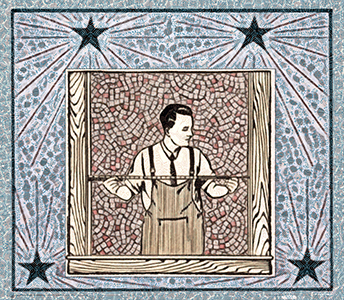
(Click on image to enlarge; may require multiple clicks to enlarge to full size)
From a 1924 Red Spot painting supplies catalog (Link1), an overall-clad handyman uses a "Boxwood Extention Rule" [sic] to measure the width of a window. Behind him, and around the window, are two differently-colored vinyl floor covering patterns, in a pattern called Mosaic, from Congoleum-Nairn's 1960 catalog. The star pattern superimposed on the linoleum comes from a brochure in the Smithsonian's miscellaneous "X-Collection," under the heading Philosophy and Linguistics (Link3): it's a 1910 program for a meeting of speakers of the artificially-constructed language Esperanto. (I studied Esperanto for a while. I was slowed by its dependence on sounds drawn from Slavic languages, but I can still read it well enough to translate the cover of the program: "La Libro de la Sesa Internacia Kongreso de Esperanto.")
(0711lapkeep-0831)
Sources:
Link1,
Link2,
Link3
Dream Vision: Home Improvement on Stacked Stenciles
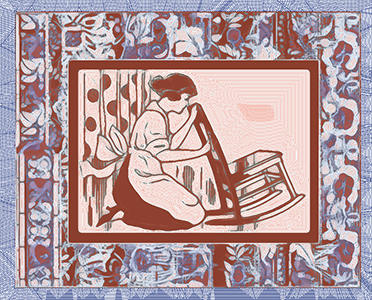
(Click on image to enlarge; may require multiple clicks to enlarge to full size)
From a 1924 catalog of painting supplies (Link1), a woman paints a rocking chair -- in the words of the company copyrwriter, she "brings new life and beauty" to "dingy furniture" with Spot-Lac Varnish Stain. Her industrious home improvement is displayed on a collage of stencils from a 1910 catalog (Link2) of stencil designs, digitally manipulated so they're unrecognizable. (0711lapkeep-0829 Plastic Club)
Sources:
Link1,
Link2
Dream Vision: Silent Screen Vamp
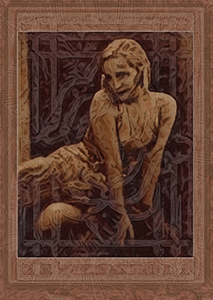
(Click on image to enlarge; may require multiple clicks to enlarge to full size)
Another image from the 1930 magazine Motion Picture Classic (Link1): Actress Dorothy Revier vamps it up in a publicity photo. That was the year that she appeared as scheming Milady de Winter in The Iron Mask. Later that year, she was in a car accident and broke both her arms. This setback began a career slide that led to her moniker, "The Queen of Poverty Row," with films like Sally of the Subway, Anybody's Blonde, and Sin's Pay Day. After she retired, she married an artist and took up painting -- but I can find no online record of her work. She died at age 89. The pose in this publicity photo (when she was 25) was so sultry and unnatural that I added a couple distancing devices: a cut-glass window overlay and some textured glass, source not recorded. (0708lapkeep---0825)
Sources:
Link1,
Dream Vision: Saint and Flapper
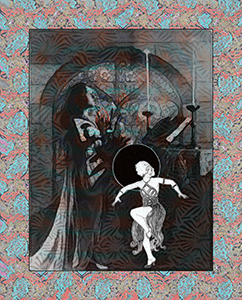
(Click on image to enlarge; may require multiple clicks to enlarge to full size)
From the April, 1929 issue of pioneer movie fan magazine Motion Picture Classic (Link1), actress Fay Wray stands prayerfully before a flowery altar in a pre-Easter publicity shot, cornily headlined "The Wraydiant Morn." Below and to the right, from a 1925 edition of Variety (Link2), a line drawing of dancer Gilda Gray, "The Golden Girl." An undertone to that 1929 picture and frame comes from a textured window-glass pattern taken from a window catalog, source not recorded. (0708lapkeep---0823)
Sources:
Link1,
Link2
Dream Vision: 20's Broadway Actress
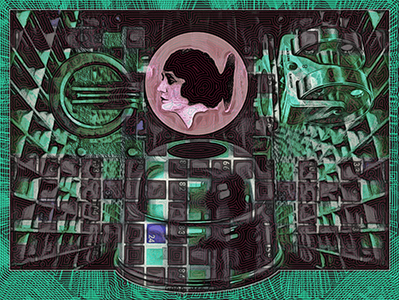
(Click on image to enlarge; may require multiple clicks to enlarge to full size)
In the purple circle at the top center, Broadway actress Ruth Robinson, who appeared in a production of Widow by Proxy (1919), a comedy about two girlfriends who switch identities to collect an inheritance (Link1). Perhaps the odd "bun" on the back of her head is some sort of mourning costume. The photo appeared in a 1921 issue of the weekly entertainment newspaper Variety (Link1). Her profile is superimposed on two pictures (flipped and rotated) of the wooden floor of a freezer tank, which appeared in a 1930 catalog of refrigeration and ice-making equipment by the Frick Company of Waynesboro, Pennsylvania. (Link2).
Surrounding Robinson's profile are, clockwise from left: a drawer pull from the 1920 catalog of Keeler Brass Company of Grand Rapids, Michigan (Link3); a set of double-wheel swivel casters from a Chicago company's 1931 catalog of cabinet hardware (Link4)' and an extra-large chrome flange from the 1931 catalog of a New York City maker of brass and rubber plumbing supplies. Finally, the image takes its color from a crossword puzzle in a Polish children's magazine (Link6).
Back from hectic trip to Pittsburgh and Detroit. First art in six days. Determined to spend more time on writing explanation and documenting sources. First image upon return is very busy -- probably a reflection of the busy-ness of this recent period. (0703lapkeep---0821)
Sources:
Link1,
Link2,
Link3,
Link4,
Link5,
Link6
Dream Vision: Movie Posters
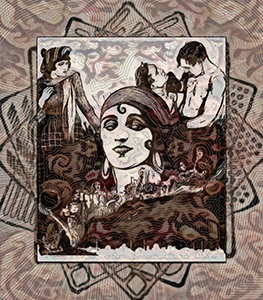
(Click on image to enlarge; may require multiple clicks to enlarge to full size)
Movie posters from an early 20th-century Variety, laid against the background of a rug and a set of plumbing screens. Largest figure is Pola Negri.(08/15/2013)
Sources: TBA
Dream Vision: Restorer
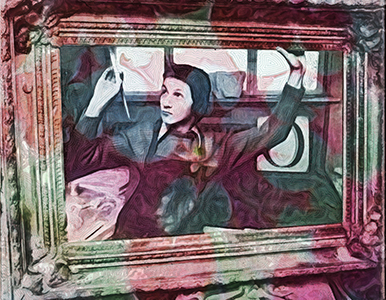
(Click on image to enlarge; may require multiple clicks to enlarge to full size)
From a magazine, a photo of an art restorer touching up a frame.
Sources: TBA
Dream Vision: Woman Tends Rug-Making Loom
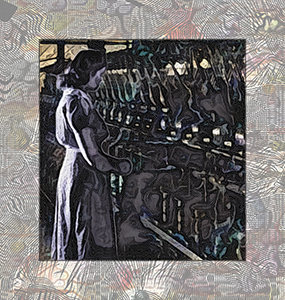
(Click on image to enlarge; may require multiple clicks to enlarge to full size)
From a 1949 rug-maker's brochure, a woman changes yarns in a machine that weaves multiple-ply floor coverings. (Link1).
(08/09/2013)
Sources:
Link1
Dream Vision in Red: Seated Woman, Storefront, & Sculpture Collection
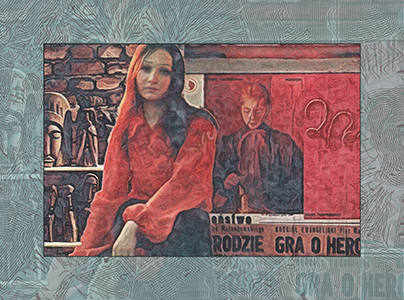
(Click on image to enlarge; may require multiple clicks to enlarge to full size)
Collage of three images from the same European magazine.
(08/07/2013)
Sources: TBA
Dream Visions: European Travel Poster, Photo of Baby's Hand
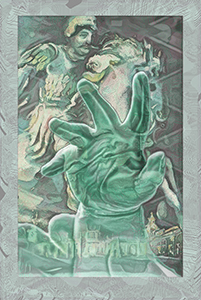
(Click on image to enlarge; may require multiple clicks to enlarge to full size)
An operatic knight and horse gallop over a European town and a baby's hand, held by an adult. The background is a Macedonian textile pattern.
(08/06/2013)
Sources: TBA
Dream Visions: Balkan Boy & Girl Reading
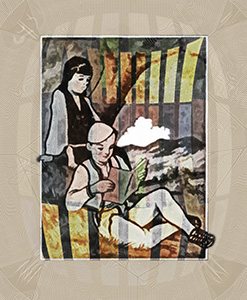
(Click on image to enlarge; may require multiple clicks to enlarge to full size)
From the Smithsonian files, the cover of a post-war ABC's reading book for an unidentified country -- my guess from the costumes would be Yugoslavia. Color is provided by a distorted image from a paint atalog.
(08/04/2013)
Sources: TBA
Dream Visions: Cleaning the Blinds
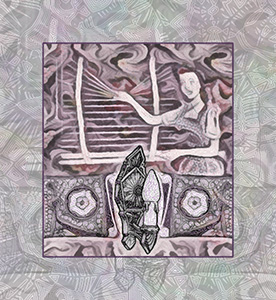
(Click on image to enlarge; may require multiple clicks to enlarge to full size)
Another housewife shows how to dust venetian blinds. Set against a background of an old rug, a ceiling lamp, and an old manuscript capital letter.
(08/03/2013)
Sources: TBA
Dream Visions: Mom Visiting in the Backyard
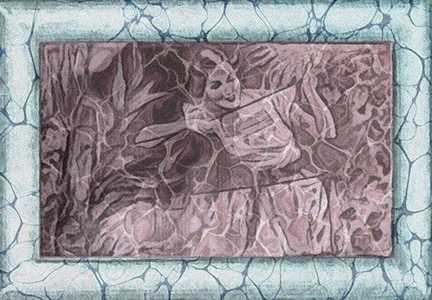
(Click on image to enlarge; may require multiple clicks to enlarge to full size)
A 1940's housewife chats with a child, leaning against a wire fence. Image is from a children's language primer from the Smithsonian archives. Background is composed of a frame from a window catalog and a marblized surface. (08/02/2013)
Sources: TBA
Dream Visions: Children's Integer Pageant
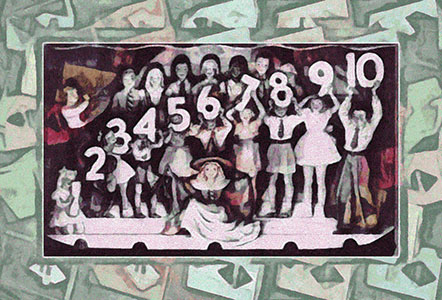
(Click on image to enlarge; may require multiple clicks to enlarge to full size)
A children's pageant on a school stage, featuring the counting numbers. The frame is composed of dye packages, digitally manipulated. (8/01/2013)
Sources: TBA
Dream Visions: Children Book Images on Marble
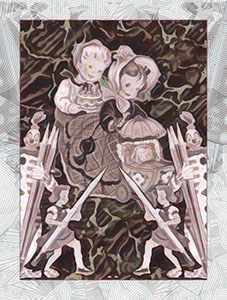
(Click on image to enlarge; may require multiple clicks to enlarge to full size)
A collage of two pictures from 1950's children's coloring books/primers scanned by the Smithsonian. They are laid over a marbleized endpaper. (7/31/2013)
Sources: TBA
Will o' Wisps, Skull, and Religious Items on Rug
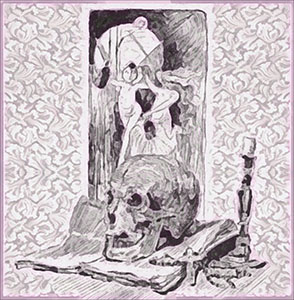
(Click on image to enlarge; may require multiple clicks to enlarge to full size)
From old books, a whimsical sketch of fairies and a grim image of death. All laid out on rug pattern. Fits my mood these days -- part tragic, part who cares?
Source: TBA
Fashion Models in Waterfront Scene
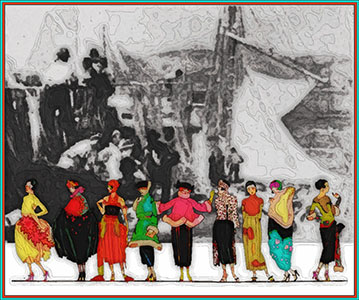
(Click on image to enlarge; may require multiple clicks to enlarge to full size)
A collage of fashionably dressed dames from Bon Ton, the late 19th century fashion magazine, combined with an image of workaday life on the waterfront, from about the same time.
Source: TBA
Flayed Man, Girl Gathering
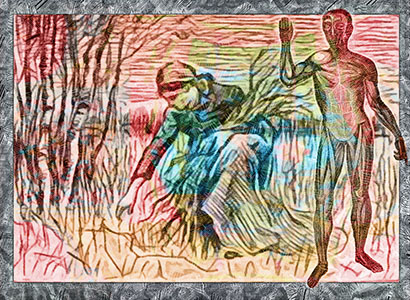
(Click on image to enlarge; may require multiple clicks to enlarge to full size)
Combination of two images: a flayed man from an old medical book and an ink drawing of a young woman gathering wood. Colors come from an old fashion magazine and background texture is a magnified photo of the Tobacco Virus, from an old agriculture book.
Source: TBA
Making Waves II
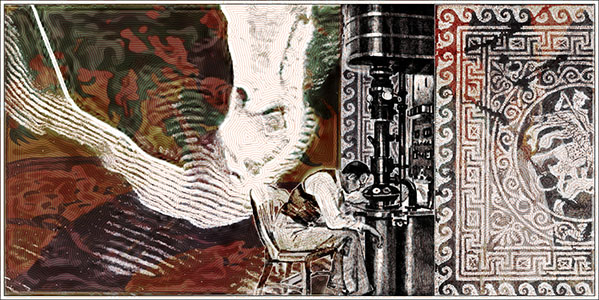
(Click on image to enlarge; may require multiple clicks to enlarge to full size)
Another dream-like image, combing the pattern of waves around a harbor, a Roman mosaic, and a scientist peering into an elecron microscope.
Source: TBA
Making Waves
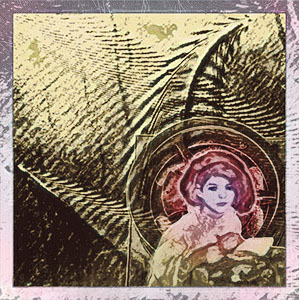
(Click on image to enlarge; may require multiple clicks to enlarge to full size)
In a more familiar, more dreamlike style. An aerial photograph of wave patterns formed by maneuvering naval vessels, a young girl from a painting, and a clock from an old book.
Source: TBA
Parisian Sophisticates in the Country
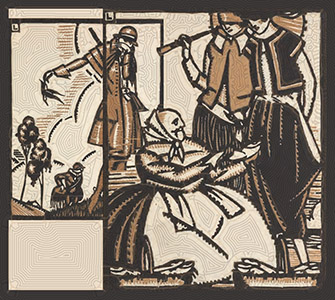
(Click on image to enlarge; may require multiple clicks to enlarge to full size)
From Bon Ton magazine (Link1), ladies in the country, buying fish from a fish-seller and weeping after shooting a bird.
Sources: Link1
Eastern European Girl Scout
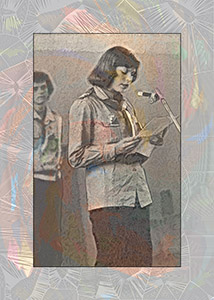
(Click on image to enlarge; may require multiple clicks to enlarge to full size)
From a 1977 issue of a Polish magazine, Plomyk (Link1) a young girl in uniform gives a speech at an assembly. Plomyk was a children and teenager's magazine, published from 1917 to 1991. The speaker is pretty, but seems to be still at that awkward age. Behind her, a boy scout keeps his thoughts to himself. I call them "scouts" but they may be members of the Young Pioneers movement of the Communist Party. Proportions may be off in graphic treatment of this image, because original was a 200 ppi image instead of usual 72 ppi. Colors come from a beautiful old painted plate appearing on the cover of a 1971 Russian magazine, Krugozor. (Link2).
Sources: Link1,
Link2
Wistful Woman, Doorways, Wheels, and Wallpaper
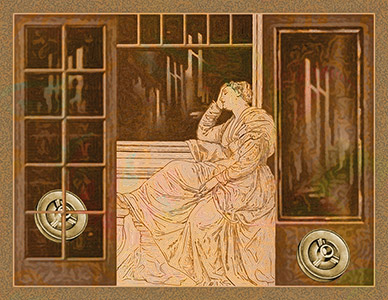
(Click on image to enlarge; may require multiple clicks to enlarge to full size)
A line-drawing based on an old painting, combined with some catalog images of doors and a metal part. Done in a hurry, like yesterday's image, on the train to visit family in Richmond, Virginia. Again, color comes from an old wallpaper pattern.
Sources: TBA
Feminist Sikh Poster and Old Jazz Singer
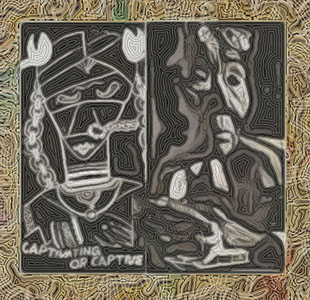
(Click on image to enlarge; may require multiple clicks to enlarge to full size)
On the left, a political poster from an Indian magazine, showing a caricature of bejeweled young woman asking the question: "Captivating or Captive?" To her right, a closeup of a an aged jazz singer from a French jazz magazine. Color comes from an old wallpaper pattern.
Sources: TBA
Woman Counting Change, Flower, Wallpaper
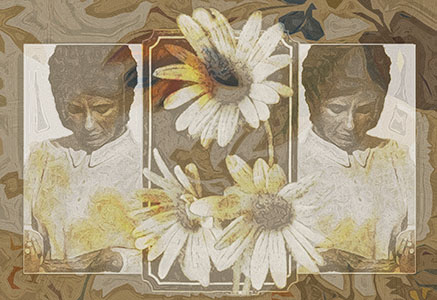
(Click on image to enlarge; may require multiple clicks to enlarge to full size)
Brow furrowed, a young woman looks at the change in her hand, from a 1968 Fotografia, a Polish photographers' magazine. (Link1). She is doubled. Between her two reversed copies appears a scene from a 1932 Garden catalog (Link2), showing a what I call "catalog style" graphic treatment, with rounded corners. And finally, color arises from a background wallpaper sample from a 1933 Home Beautiful catalog of the latest wallpaper styles (Link3).
Sources: Link1,
Link2, and
Link3
Store Window with Peacocks, Nuts and Vaudeville Team
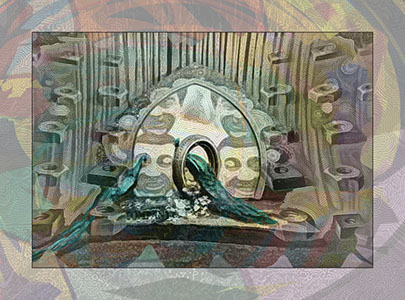
(Click on image to enlarge; may require multiple clicks to enlarge to full size)
A complicated image with three sources. First, a photo of a show window from a 1927 catalog of display lighting (Link1). The window displays a U.S. Rubber tire paired incongruously with two peacocks. Cut into the display image is a picture of two members of a vaudeville act (The McNaughtons) from a 1907 Variety show-biz newspaper. And finally, a page of nuts from a 1924 catalog of Empire brand hardware from a Port Chester, New York, company (Link3).
Sources: Link1,
Link2, and
Link3
Squatting Woman on Catalog-Style Rectangle
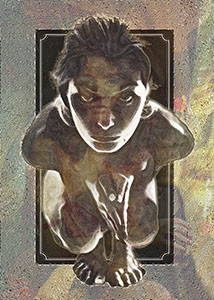
(Click on image to enlarge; may require multiple clicks to enlarge to full size)
More of an experiment this time, a picture of a naked woman squatting on her heels, taken from above, which appeared in a 1971 Polish photography magazine called Fotografia (Link1). It is combined with a black rectangle with a white internal framing line. The black rectangle/white frame style was a layout style used in old commercial garden catalogs. Color is provided by another
photograph from the same issue of Fotografia, radically distorted so only the color shows through, although you can glimpse the sad, tired eyes of the model above the eyes of the seated woman and her hand in the lower right.
Sources: Link1
Playing a Japanese Koto in Middle American Bank
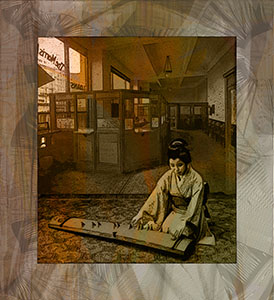
(Click on image to enlarge; may require multiple clicks to enlarge to full size)
At the top, a photo from the 1910 catalog (Link1) of Add-A-Unit, a company that made bank and office partitions. It shows the interior of a downtown American bank of the early 20th century. Below that, from a 1908 History of Foreign Music (Link2), a picture of a Japanese woman playing a Koto stringed instrument. The book assumes the superiority of Western/German music. For instance, snooty author Hilton Pedley's chapter on Japan begins: "After General Kuropatkin, of the Russian Army, had visited Japan shortly before the great war of 1904-1905, he is said to have remarked that Japan's utter lack of musical taste was an insuperable barrier to her ranking among the first nations of the earth. Today, the little island country does rank among the first nations, as Kuropatkin has learned to his cost; but whether this has come about because of a genuine musical taste, or in spite of its absence, is quite another matter."
The background color comes from radical digital manipulation of a photo of an actress in Scena, a 1981 theatre magazine from Warsaw, Poland.
Sources: Link1,
Link2,
Link3
To contact Philly-Bob, email me at admin [at symbol] philly-bob.net (of course, replace "[at symbol]" with "@"]. Be patient. I only check that address once a month.